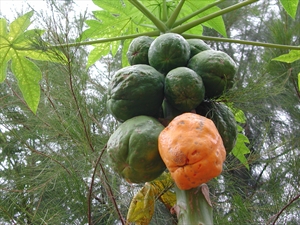Lumpy fruit of papaya, brown heart of celery
Pacific Pests, Pathogens, Weeds & Pesticides - Online edition
Pacific Pests, Pathogens, Weeds & Pesticides
Papaya & celery boron deficiency (191)
Boron deficiency
Likely in many countries where papaya and celery are grown.
Papaya and celery, but boron deficiency also occurs in many other plants, for instance, brassicas (e.g., broccoli, cauliflower, turnip), sweetpotato, and palms.
On papaya, symptoms of boron deficiency usually start when fruit are young, but it is on the mature fruit that they become most obvious (Photos 1&2). Fruits are deformed, plants are stunted and leaves are brittle and claw-like. Seeds, if present, fail to germinate. In some cases, fruits develop 3-4 mm long cracks which ooze drips of latex. Deficiency symptoms may be seasonal, severe at certain times of the year, and absent at other times.
On celery, symptoms of boron deficiency show as splits across the veins of the leaf bases (petioles). Later, the tissues between the cracks curl backwards (Photo 3). The inner, younger, leaves blacken and develop wet rots (Photo 4).
Boron occurs naturally in most soils, and is also present in decomposing organic matter. However, in many tropical countries the high rainfall washes boron from the soil. Boron deficiency can also occur in soils with high pH, especially where there are dry seasons. In this case, the boron is held by the soil and cannot be taken up by plant roots.
Boron is only needed in very small amounts, but it is very important in cell wall formation, cell division and the way that plants use nitrogen. It is also needed for pollination and seed production.
In Hawaii, total loss of papaya crops has been reported due to boron deficiency. The quality of fruits is affected by bumps and lumps over the surface, low sugar content and uneven colour.
Look for papaya fruit with characteristic lumpy appearance; look for discharge of latex from the fruits. Look for celery with splits on the petioles, and rots on the young leaves.
Leaf analyses are needed to confirm that plants are suffering from boron deficiency. Collect leaves from healthy and diseased plants of the same age and position near the shoot tip. Collect samples of soil from around the celery and papaya plants for analysis. Boron deficiency occurs if the leaves have 20 ppm and below. Normal levels are 25 ppm and higher.
CULTURAL CONTROL
Boron is only needed in small amounts, and the difference between deficiency and toxicity is small. The best way to treat boron deficiency is to add plenty of compost, as boron is present in organic matter. If that does not solve the problem, then use borax.
Note, boron deficiency may not simply be caused by a lack of boron, but by a lack of balance between levels of boron and potassium, nitrogen and calcium. So, if symptoms persist, it would be best to carry out soil analyses to arrive at the correct solution. It is also influenced by pH.
RESISTANT VARIETIES
Celery varieties differ in susceptibility to boron deficiency.
CHEMICAL CONTROL
- For papaya:
- Spay leaves or drench the soil with a 0.3% borax (sodium tetraborate) solution. After 3 months, papaya fruit will develop normally.
- Alternatively, apply 0.5 g borax around the base of each tree. A drench of borax (as above) can also be applied to the roots. If this does not solve the problem increase the amount of borax up to 5 g per tree.
- For celery:
- Add 2 g borax per m2 to the soil, 2 and 6 weeks after planting, and water plants well, so that the roots take up the boron.
- A number of commercial products are available that can be used; they are formulated in such a way to keep boron dispersed and soluble in water.
AUTHOR Grahame Jackson
Information from Nelson S (2012) Boron deficiency of papaya. Department of Plant and Environmental Protection Services, College of Tropical Agriculture and Human Resources, University of Hawai'i at Manoa. (https://www.ctahr.hawaii.edu/oc/freepubs/pdf/pd-91.pdf). Photo 3 Bill Mansour, Oregon State University. Photo 4 Kohler F, et al. (1997) Diseases of cultivated crops in Pacific Island countries. South Pacific Commission. Pirie Printers Pty Limited, Canberra, Australia.
Produced with support from the Australian Centre for International Agricultural Research under project PC/2010/090: Strengthening integrated crop management research in the Pacific Islands in support of sustainable intensification of high-value crop production, implemented by the University of Queensland and the Secretariat of the Pacific Community.







